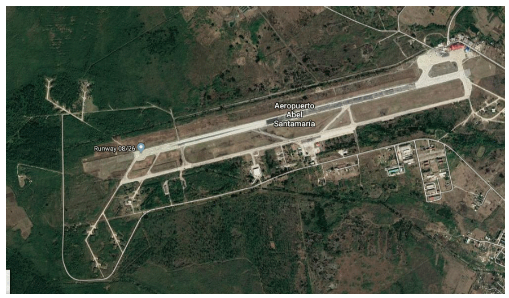Synoptic configurations associated with fog and haze at the international airport "Abel Santamaría"
Main Article Content
Abstract
Fog and haze are a meteorological phenomenon of reduced visibility of aerodromes. At the Abel Santamaría international airport, the appearance of these phenomena is frequent throughout the year, which affects the security and regularity of airport operation's, mainly in the morning hours. In order to identify the synoptic configurations associated with fog and haze at Abel Santamaría international airport, mean synoptic maps of different meteorological variables of 315 days were examined where these phenomena were present. Four synoptic configurations associated with the occurrence of these events at the aerodrome were determined, while the anticyclonic influence being the most frequent situation. In addition, it was detected that the period of greatest occurrence covers the months of October to April, which largely coincides with the dry season in Cuba. With respect to atmospheric variables, it was found that both the high values of relative humidity in low level and the descending movements of the synoptic scale are factors that favor the occurrence of fog or haze.
Downloads
Article Details

This work is licensed under a Creative Commons Attribution-NonCommercial 4.0 International License.
Those authors who have publications with this journal accept the following terms of the License Attribution-NonCommercial 4.0 International (CC BY-NC 4.0):
You are free to:
- Share — copy and redistribute the material in any medium or format
- Adapt — remix, transform, and build upon the material
The licensor cannot revoke these freedoms as long as you follow the license terms.
Under the following terms:
- Attribution — You must give appropriate credit, provide a link to the license, and indicate if changes were made. You may do so in any reasonable manner, but not in any way that suggests the licensor endorses you or your use.
- NonCommercial — You may not use the material for commercial purposes.
- No additional restrictions — You may not apply legal terms or technological measures that legally restrict others from doing anything the license permits.
The journal is not responsible for the opinions and concepts expressed in the works, they are the sole responsibility of the authors. The Editor, with the assistance of the Editorial Committee, reserves the right to suggest or request advisable or necessary modifications. They are accepted to publish original scientific papers, research results of interest that have not been published or sent to another journal for the same purpose.
The mention of trademarks of equipment, instruments or specific materials is for identification purposes, and there is no promotional commitment in relation to them, neither by the authors nor by the publisher.
References
Álvarez, E., Borrajero, M., Álvarez, M., & León, L. (2011). Estudio de la marcha interanual de la frecuencia de ocurrencia de los fenómenos nieblas y neblinas a partir del código de estado de tiempo presente. Revista Ciencias de la Tierra y el Espacio, 12, 31-46.
Croft, P. J., Pfost, R. L., Medlin, J. M., & Johnson, G. A. (1997). Fog forecasting for the southern region: A conceptual model approach. Weather and Forecasting, 12(3), 545-556.
D’Antiochia, G., Schiazzano, M., & Auzmendia, D. (2014). Tratamiento de fenómenos meteorológicos severos para la aviación en el Aeropuerto Ezeiza. III Congreso Argentino de Ingeniería Aeronáutica (CAIA 3), La Plata, Argentin.
Entenza, L. (2007). Estudios sobre la ocurrencia de niebla en el Aeropuerto Internacional “José Martí”. Memorias del IV Congreso Cubano de Meteorología, La Habana, Cuba.
Fernández, A., & Díaz, Y. (2005). Catálogo de Procesos Sinópticos del Archipiélago Cubano en el período 1979-1993 [Catálogo].
Grillo, N. (2013). La niebla en el Aeropuerto Internacional José Martí, su relación con los eventos y variables meteorológicas [Tesis de Grado]. Instituto Superior de Tecnología y Ciencias Aplicadas.
Guzmán, L. (2013). Condiciones favorables para la ocurrencia de nieblas en Cuba [Tesis de Licenciatura en Meteorología]. Instituto Superior de Tecnologías y Ciencias Aplicadas.
IACC. (2017). Manuales Aeronáuticos Cubanos (Manual 5ta Edición). Instituto de Aviación Civil de Cuba.
Kunkel, B. A. (1984). Parameterization of droplet terminal velocity and extinction coefficient in fog models. Journal of Applied Meteorology and Climatology, 23(1), 34-41.
Ledesma, M., & Baleriola, G. (2002). Meteorología aplicada a la aviación. International Thomson Paraninfo.
Marín, J. R. (1981). Nieblas en el aeropuerto de Sevilla.
Martínez Mancera, A. R. (2015). Análisis de las condiciones a escala local para el pronóstico de niebla o neblina en el aeródromo “Ernesto Esguerra Cubides [Tesis de Maestría]. Departamento de Geociencia.
Rojas, Y., Maura, L., Carnesoltas, M., & Laborde, N. (2008). Comportamiento de la niebla y la neblina en la provincia Guantánamo. IV Congreso Cubano de Meteorología Tropical, Convención Trópico 2008, La Habana, Cuba.
Ryerson, W. R. (2012). Toward improving short-range fog prediction in data-denied areas using the Air Force Weather Agency mesoscale ensemble. NAVAL POSTGRADUATE SCHOOL MONTEREY CA.
Solares Miranda, A. (2014). Comportamiento de la niebla en el área del aeropuerto internacional «Ignacio Agramonte» de Camagüey en el período 2000-2012 [Tesis de Grado]. Instituto Superior de Tecnología y Ciencias Aplicadas.

